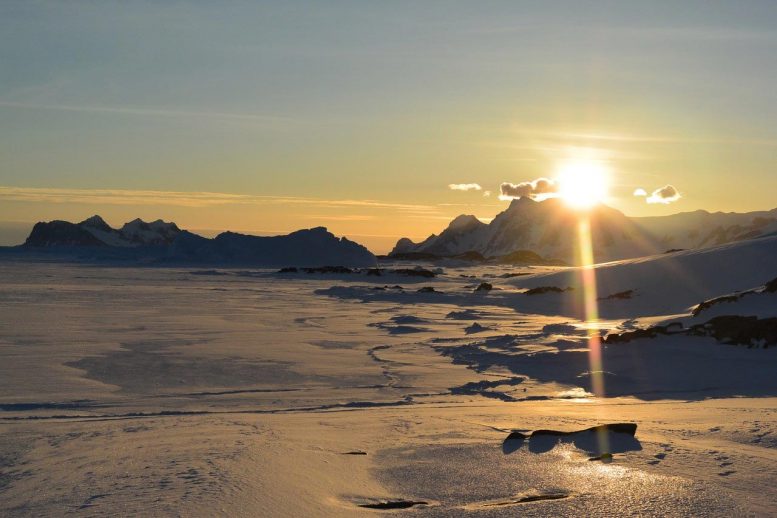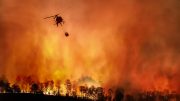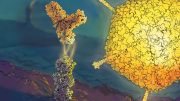The Antarctic ice sheet was even more unstable in the past than previously thought, and at times possibly came close to collapse, new research suggests.
The findings raise concerns that, in a warmer climate, exposing the land underneath the ice sheet as it retreats will increase rainfall on Antarctica, and this could trigger processes that accelerate further ice loss.
The research is based on climate modeling and data comparisons for the Middle Miocene (13-17 million years ago) when atmospheric carbon dioxide and global temperatures reached levels similar to those expected by the end of this century.
The study was carried out by the Met Office, the universities of Exeter, Bristol, Cardiff, Stockholm, NORCE, and the Bjerknes Centre for Climate Research.
“When an ice sheet melts, the newly exposed ground beneath is less reflective, and local temperatures become warmer,” said lead author Dr Catherine Bradshaw, of the Met Office and the Global Systems Institute at the University of Exeter.
“This can dramatically change weather patterns.
“With a big ice sheet on the continent like we have today, Antarctic winds usually blow from the continent out to the sea. However, if the continent warms this could be reversed, with the winds blowing from the cooler sea to the warmer land — just as we see with monsoons around the world.
“That would bring extra rainfall to the Antarctic continent, causing more freshwater to run into the sea.
“Freshwater is less dense than saltwater and so it can sit on the sea surface, rather than sinking and circulating as saltwater does. This effectively breaks the connection between the deep ocean and the surface ocean, causing warmer water to accumulate at depth.”
The study suggests that the processes triggered by increasing rainfall would reduce the ability of the climate system to maintain a large Antarctic ice sheet.
“Essentially, if more land is exposed in Antarctica, it becomes harder for a large ice sheet to reform, and without favorable orbital positions in the Middle Miocene playing a role, perhaps the ice sheet would have collapsed at that time,” Dr Bradshaw said.
During the warm Middle Miocene period, unusually large swings back and forth in deep-sea temperatures were recorded.
The study shows that fluctuations in the area covered by the ice sheet were a major factor in causing deep-sea temperatures to change so dramatically. Fluctuations in the volume of ice were found to be of much less importance.
Variations in the positioning of the Earth relative to the Sun caused the ice sheet to advance and retreat, and this altered weather patterns — triggering processes that can accelerate ice loss or gain.
Rain falling on the ice sheet can cause fracturing, surface melt and extra freshwater running off the continent, which, in turn, can cause deep-sea temperatures to rise — potentially influencing Antarctic ice from beneath.
The findings of the new study suggest that the Antarctic ice sheet retreated significantly during the Middle Miocene, then stabilised when the warm period ended.
Co-author Associate Professor Agatha De Boer, from the University of Stockholm, said: “When the Middle Miocene climate cooled, the link we have found between the area of the ice sheet and the deep-sea temperatures via the hydrological cycle came to an end.
“Once Antarctica was fully covered by the ice sheet, the winds would always go from the land to the sea and as a result rainfall would have reduced to the low levels falling as snow over the continent we see today.”
Dr Petra Langebroek, a Senior Researcher from NORCE and the Bjerknes Centre for Climate Research, another co-author, added: “These findings imply a shift in ocean sensitivity to ice sheet changes occurs when ice sheet retreat exposes previously ice-covered land.”
Professor Carrie Lear, from Cardiff University, who first devised the project, concluded: “This study suggests that during a warm period about 15 million years ago, the Miocene Antarctic ice sheet was capable of major advance and retreat across the continent.
“This is concerning, but further research is needed to determine exactly what this means for the long-term future of the modern Antarctic ice sheet.”
Dr Bradshaw stressed that conditions now are not identical to those in the Middle Miocene, and the model used in the study does not include the impact of feedbacks from the carbon cycle or the ice sheet itself.
Reference: “Hydrological impact of Middle Miocene Antarctic ice-free areas coupled to deep ocean temperatures” by Catherine D. Bradshaw, Petra M. Langebroek, Caroline H. Lear, Daniel J. Lunt, Helen K. Coxall, Sindia M. Sosdian and Agatha M. de Boer, 13 May 2021, Nature Geoscience.
DOI: 10.1038/s41561-021-00745-w
The study was funded by the Natural Environment Research Council and the Swedish Research Council.










we shall see as it’s just a theory for now. give it about 10 years to mature to see if proven real or not.
“Freshwater is less dense than saltwater and so it can sit on the sea surface, …’
And freshwater freezes at a higher temperature, increasing the areal extent of shelf ice and reducing evaporation to supply the conjectured rain. Yes, monsoons bring rain today when the moisture source is sub-tropical. But India and Arizona are closer to the tropics than Antarctica is! And, they are too warm for snow during the monsoon season.
Why were the CO2 levels in the Miocene similar to today?
This strikes me as more scaremongering based largely on conjecture and models more suited to temperate zones.
The most important statement in the article is, “This is concerning, but further research is needed to determine exactly what this means for the long-term future of the modern Antarctic ice sheet.” Translation: “Send more money.”
Might sound dumb but why not put a big reflective tarp over it. All this technology and they can’t figure out anything but to destroy the planet.
I am amazed at how much time effort and MONEY is spent on how and why an ICE CUBE Melts. People in and all around the Globe have EYE’S and see what you are trying minutly scrutinise ICE CUBE Melt in every unimaginable possile maybe WAYS. Everyday You say the Earth is FALLING the Earth is FALLING,,,,,, yeah,,, so! There is only ‘1’ SOLUTION! Answer is at JW.ORG
I see lots of comments that are based on their politics instead of science. The worst thing possible is the concept of denial which is mindset of of a weak mindset. Look at the trends, verify, check and check again. Build the model and test the hypothesis and confirm. Test again. Everything I see in science is tested on a regular basis. Denial philosophy needs to be expunged. Being a bit sceptical is ok and health but, denialists need to be outright dismissed. Denial philosophy is poisonous to critical thinking; which is the foundation of science. Thanks to the science community for showing reality as it truly is and keeping the faith of knowledge through verification.
“Build the model and test the hypothesis and confirm. Test again. Everything I see in science is tested on a regular basis.”
Done properly, models should be tested rigorously for their skill in predicting. However, the extant models (except the Russian model) run too warm, often get the sign on precipitation opposite to other models, and in general, do a poor job of regional forecasting. The climatology models are routinely wrong, and the problems aren’t addressed. The models are essentially computer implementations of complex hypotheses. In the Scientific Method, models that don’t work right are either rejected outright, or subjected to modifications until they do. We aren’t there yet with respect to global circulation models!
Can someone tell me. If you keep burning oxygen what are we going to breath Is it replenished by trees which keep getting chopped down?
Just a thought: in the beginning a solid piece of ice a thousand times larger than the earth was impacted by a red hot asteroid we will call earth, this is where all the water came from which formed our atmosphere the oceans as well as subteranian water this was the only ice age and it is finally disappearing no matter what man does we are in trouble. The seed and life was in the water
220 FEET OF SEA LEVEL RISE COLLAPSING BY END OF 2023 ?
What We Have Now, Is a Broken Up and New Jet Stream, Centered From Greenlands 20 feet of Sea Level Rise of Ice and Snow
Moving Over 17 degrees from the Center of the Arctic. To Greenland, an Is Now Being Pierced, and Lobed
Because of Mantle Methane, Methane Hydrates, Pingoes, Perma Frost, Fracking, all emitting Methane NOW ! and Emitting over 40 – 50 Billion Toxic Tons of Carbon each year Globally.
All this Hot Gas has Melted the Arctic and Will Bring a Blue Arctic in 2021
It Has Pierced the Greenland Jet Stream in to Lobes, Moving it Over 17 degrees from The Center of The Arctic and Stopped over 3 Million years of Glaciation
The Hot Gas Fueled the Insane Arctic, Greenland, and Antarctic Ice Melts.
Has Roared its Global Warming Frontal Lobes with Record Setting Temperatures and Record Setting Snow, and Record Setting Rain.
These Methane, and Carbon Molecules Have Roared Their Increased Water Vapor and Global Warming Gases, That will Set Record Heat, Record Snow, Until Greenland Collapses
109F. PALM SPRINGS CA 4/30/21
100F. SIBERIAN ARCTIC 6/21/20
111F. MÉXICO Gallinas 3/27/21
METHANE NATURAL GAS
NITROUS OXIDE
WATER VAPOUR
CARBON
= 8C. GLOBAL TEMP RISE SINCE 1700s
DEADLY HEAT RAIN WIND SNOW EACH & EVERY YEAR
NAGASAKI HIROSHIMA FUKUSHIMA
444 Nuclear Reactors
450 Nuclear Facilities
1,300 Nuclear Fuel Rod Pools
2,000 Nuclear Detonations
14,000 Nuclear Weapons
250,000 Toxic Tons Of Radiated Nuclear Waste Globally
220 FEET OF SEA LEVEL RISE COLLAPSING END 2023. ?
https://www.youtube.com/watch?v=v9GRkZMTqCs
We Are Going To Be Fukushimatized
Then Just Record Rain, and Record Heat Year After Fossil Fuel Nuclear Radiated Year.
220 feet of Sea Level Rise by the End of 2023 ?
When Will Greenland and Antarctica Collapse ?
Great Lakes Lake Levels Rising Because of Record Rain an Greenland Melting
All That Ice an Snow Is Heavy Water Coming Off Of Greenland and Antarctica Sinking The Ocean Floors Putting Pressure on the Thermal Convection Belt Between The Crust an Mantel
This Stress is Relieved By Lava Magma Eruptions and Plate Tectonic Movements
Earth Quakes and Volcanos
There is Still Over 218 Feet of Sea Level Rise to Sink the Ocean Floors
When Will Greenland and Antarctica Collapse ?
Will They Collapse This Winter ?
The Past Three Winters It Has Been Raining In Greenland
Will Greenland Collapse in a Winter Rain Bomb ?
220 FEET SEA LEVEL RISE END 2023 ?
https://www.youtube.com/watch?v=v9GRkZMTqCs